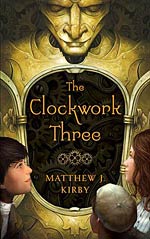
![]() Rhondak101
Rhondak101
7/15/2014
![]()
The history of child labor is an interesting one. Matthew J. Kirby's The Clockwork Three centers on American child labor in three different forms. The setting is an American city in the late-1800s. Hannah, who is around fourteen, works as a maid at a large hotel. She works because her father suffered a stroke at an early age and is bed-ridden. Her mother stays at home to care for her husband and the younger children. Frederick is an orphan who is apprenticed to a clockmaker. He was previously in the city orphanage, which is really a textile mill in disguise. It is his talents in working on the looms that bring him to the attention of adults who can arrange his release from the orphanage. Giuseppe is an Italian orphan whose uncle sold him to Stephano, a padrone who sponsored Giuseppe's immigration into America. Stephano trains the orphans to play music and sends them out daily to busk for him. Each of these three children are trapped in their situations. Each adult, whether they love the child or not, exploits the child because of his or her economic worth. As the children meet each other and tell their stories, they learn that they can help one another. They also learn that some adults can be benefactors rather than exploiters.
This is a very strong first novel that Kirby based on a real life analog of Giuseppe. Joseph made the news in 1873 when he escaped his padrone and hid in Central Park. Joseph's testimony helped change the padrone laws that previously enabled the virtual enslavement of young boys.